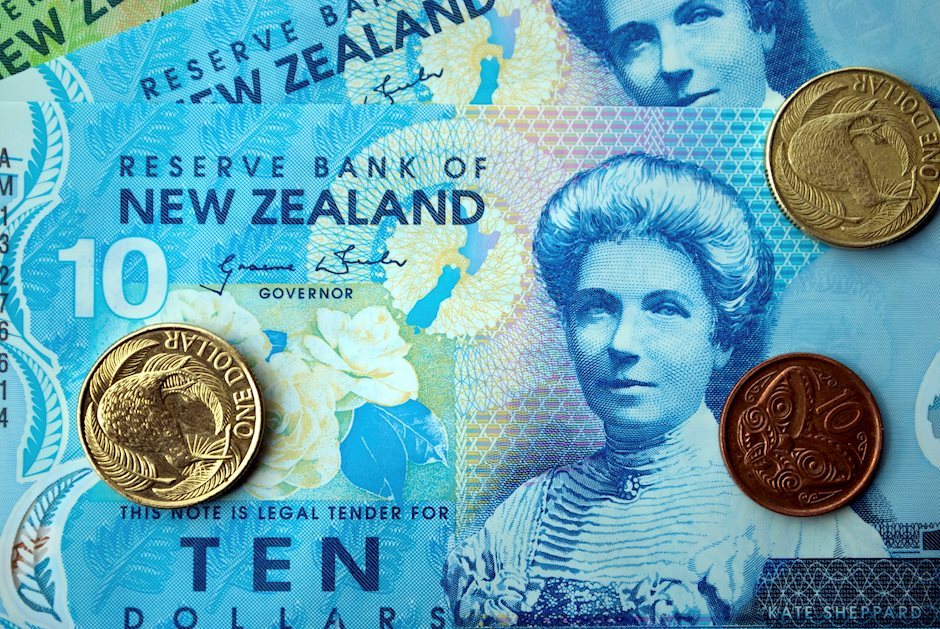NZD/USD remains below 0.6100 as US Dollar appreciates on rising risk aversion
- NZD/USD edges lower as the US Dollar gains support from the fading likelihood of further bumper rate cuts by the Fed.
- Fed’s Kashkari reiterated the central bank’s data-dependent approach, highlighting the ongoing easing of inflationary pressures alongside a strong labor market.
- New Zealand’s Consumer Price Index is anticipated to return to the central bank's 1-3% target range for the September quarter.

NZD/USD halts its three-day winning streak, trading around 0.6080 during the Asian hours on Tuesday. This downside could be attributed to the stronger US Dollar (USD), which gains support from fading expectations that the US Federal Reserve (Fed) will implement aggressive interest rate cuts following a strong jobs report and concerns about sticky US inflation.
The US Dollar Index (DXY), which measures the value of the US Dollar against its six other major peers, extends its winning streak for the sixth consecutive day on Tuesday. The DXY trades around 103.30 with 2-year and 10-year standing at 3.96% and 4.09%, respectively, at the time of writing.
On Monday, Federal Reserve (Fed) Bank of Minneapolis President Neel Kashkari reaffirmed the Fed's data-dependent approach. Kashkari reiterated familiar Fed policymaker views on the strength of the US economy, noting continued easing of inflationary pressures and a robust labor market, despite a recent uptick in the overall unemployment rate, per Reuters.
The New Zealand Dollar (NZD) weakened following Monday’s disappointing trade balance data from China, New Zealand's largest trading partner. Additionally, despite the announcement of China’s fiscal stimulus plan over the weekend, the Kiwi Dollar did not gain traction, as investors remained uncertain about the extent of the package.
China's trade surplus narrowed in September, with the Trade Balance recorded at 81.7 billion, falling short of the 89.8 billion expected and down from the previous 91.02 billion. Exports increased by 2.4% year-over-year, significantly lower than the anticipated 6.0% and down from 8.7% in the prior period. Meanwhile, Imports grew by 0.3%, below the expected 0.9% and the previous increase of 0.5%.
Investors are likely anticipating the release of New Zealand's third-quarter inflation data on Wednesday. The Consumer Price Index (CPI) is expected to fall back within the central bank's 1-3% target range, decreasing to 2.2% year-over-year for the September quarter from the previous 3.3% reading.
The New Zealand Dollar is under downward pressure as markets anticipate an 80% likelihood that the Reserve Bank of New Zealand (RBNZ) will execute another half-point rate cut at its final meeting of the year in November.
New Zealand Dollar FAQs
The New Zealand Dollar (NZD), also known as the Kiwi, is a well-known traded currency among investors. Its value is broadly determined by the health of the New Zealand economy and the country’s central bank policy. Still, there are some unique particularities that also can make NZD move. The performance of the Chinese economy tends to move the Kiwi because China is New Zealand’s biggest trading partner. Bad news for the Chinese economy likely means less New Zealand exports to the country, hitting the economy and thus its currency. Another factor moving NZD is dairy prices as the dairy industry is New Zealand’s main export. High dairy prices boost export income, contributing positively to the economy and thus to the NZD.
The Reserve Bank of New Zealand (RBNZ) aims to achieve and maintain an inflation rate between 1% and 3% over the medium term, with a focus to keep it near the 2% mid-point. To this end, the bank sets an appropriate level of interest rates. When inflation is too high, the RBNZ will increase interest rates to cool the economy, but the move will also make bond yields higher, increasing investors’ appeal to invest in the country and thus boosting NZD. On the contrary, lower interest rates tend to weaken NZD. The so-called rate differential, or how rates in New Zealand are or are expected to be compared to the ones set by the US Federal Reserve, can also play a key role in moving the NZD/USD pair.
Macroeconomic data releases in New Zealand are key to assess the state of the economy and can impact the New Zealand Dollar’s (NZD) valuation. A strong economy, based on high economic growth, low unemployment and high confidence is good for NZD. High economic growth attracts foreign investment and may encourage the Reserve Bank of New Zealand to increase interest rates, if this economic strength comes together with elevated inflation. Conversely, if economic data is weak, NZD is likely to depreciate.
The New Zealand Dollar (NZD) tends to strengthen during risk-on periods, or when investors perceive that broader market risks are low and are optimistic about growth. This tends to lead to a more favorable outlook for commodities and so-called ‘commodity currencies’ such as the Kiwi. Conversely, NZD tends to weaken at times of market turbulence or economic uncertainty as investors tend to sell higher-risk assets and flee to the more-stable safe havens.
Author

Akhtar Faruqui
FXStreet
Akhtar Faruqui is a Forex Analyst based in New Delhi, India. With a keen eye for market trends and a passion for dissecting complex financial dynamics, he is dedicated to delivering accurate and insightful Forex news and analysis.
















